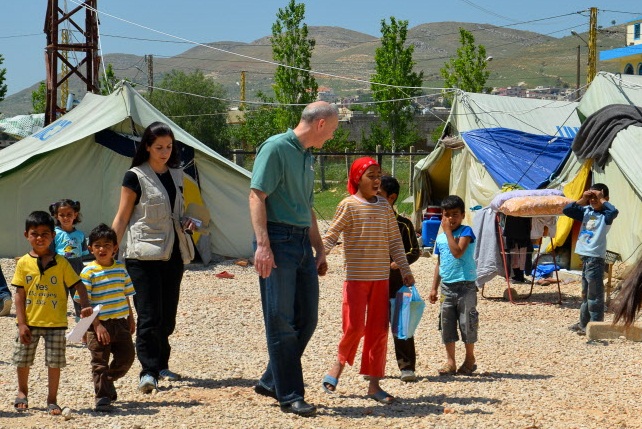A protective eco-system for Syria’s children

Wednesday 24 September, New York: World Vision President Kevin Jenkins urged governments and key decision makers to work together to create protective eco-systems for refugee children from the crisis in Syria.
Speaking at a United Nations special meeting this afternoon he supported calls for more action on behalf of children and youth displaced by endless conflict in Syria.
"We must persevere and act together to protect the children of Syria."
“When you travel in Lebanon and Jordan and meet the children who have had to flee their homes, every story is heart-breaking,” he told the No Lost Generation meeting organised by UN children’s agency UNICEF.
“Their lives have been severely interrupted.
“As one member of our relief staff told me in Beirut, they are in limbo-land. It’s as though their lives have been put on hold.”
Creating stand-alone programmes for children is important, but not enough, Jenkins told the meeting of concerned government leaders, UN heads of agency and civil society principals.
“Rather, we all need to work closely together to ensure every aspect of children’s lives works together to ensure their protection.”
“Children didn’t start this conflict … and they’re not in a position to end it.”
The psycho-social counselling that WV has provided to 1.3 million children will quickly unravel if they attend schools where they get bullied, he said. And safe schools, while greatly needed, won’t have the desired impact if the children go home to drink filthy water.
Considering there are more than six million children whose lives have been affected, inside and outside Syria, the logistics are immense, he acknowledged – one of the biggest challenges the humanitarian community has faced this generation.
The onus is on us to act, however. “Children didn’t start this conflict … and they’re not in a position to end it.”
Jenkins cited the example of World Vision Lebanon, where experts are pioneering a change in mind-set regarding child protection. They are thinking about the whole “eco-system” in which displaced children live, creating space for children to talk about the upheaval they have endured and the burdens they continue to bear.
Hoda, 11, is Kevin Jenkins' guide to the informal settlement in which she lives in Lebanon. Photo by Nigel Marsh
Recent advocacy reports, in particular one that was written by representatives of the children themselves, shows the need is increasingly urgent. Although Syrian children no longer feature much in media coverage, the pressures on them are mounting.
“Rates of child labour are rising. The average age of marriage for Syrian girls is falling. Children are terrified of being reduced to begging for food. They watch their jobless parents lose hope, and wonder what kind of future awaits them.”
As the crisis drags on, the generous welcome by people in neighbouring countries is stretching thin, he noted.
“Children sense this; and they fear the world will forget them,” he concluded.
“We won’t! We must persevere and act together to protect the children of Syria.”
More about the children of Syria:
-- World Vision concerned children may never recover from this crisis
-- Our Uncertain Future: Syrian children speak of their fears for the future
-- Haunted by what he saw in Syria: Amir, 10, tells his story
